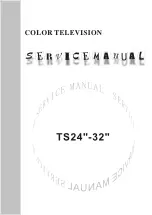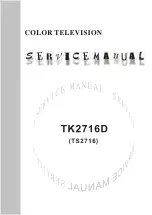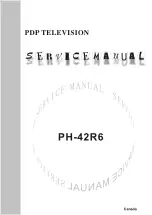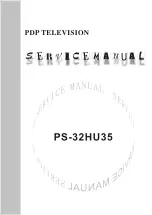
-31-
5. Pin Descriptions for PSDIP64 package
Pin 1,2,5-10, P17 P10 I/O Port (Fig. 6–27)
These pins provide CPU controlled I/O ports. P10 can
be configured as video input VIN5 (Fig. 6–9) on VCT
38xxB only!
Pin 3, VSUPP1* Supply Voltage, Port 1 Driver This pin
is used as supply for the I/O port 1 driver.
Pin 4, GNDP1* Ground, Port 1 Driver
This is the ground reference for the I/O port 1 driver.
Pin 11, VOUT Analog Video Output (Fig. 6–12)
The analog video signal that is selected for the main
(luma, CVBS) adc is output at this pin. On VCT 38xxB
this pin can also deliver the sum of luma and chroma
input signals (S-VHS). An emitter follower is required at
this pin.
Pin 12, VRT Reference Voltage Top (Fig. 6–13)
Via this pin, the reference voltage for the A/D
converters is decoupled. The pin is connected with 10
F/47 nF to the Signal Ground Pin.
Pin 13, SGND Signal GND for Analog Input
This is the high quality ground reference for the video
input signals.
Pin 14, GNDAF* Ground, Analog Front-end
This pin has to be connected to the analog ground. No
supply current for the digital stages should flow through
this line.
Pin 15, VSUPAF* Supply Voltage, Analog Front-end
This pin has to be connected to the analog supply volt-
age. No supply current for the digital stages should flow
through this line.
Pin 16,18, CBIN,CRIN Analog Chroma Component
Input (Fig. 6–11)
These pins are used as the chroma component
(CB,CR) inputs required for the analog YUV Interface.
The input signal must be AC-coupled. The CRIN pin
can alternatively be used as the second SVHS chroma
input (CIN2).
Pin 17,18, CIN1,CIN2 Analog Chroma Input (Fig. 6–10)
These are the analog chroma inputs. A S-VHS chroma
signal is converted using the chroma (Video 2) AD
converter. A resistive divider is used to bias the input
signal to the middle of the converter input range. The
input signal must be AC-coupled. The CIN2 pin can
alternatively be used as the chroma component (CR)
input required for the analog YUV Interface.
Pins 1922, VIN1–4 Analog Video Input (Fig. 6–9)
These are the analog video inputs. A CVBS or S-VHS
luma signal is converted using the luma (Video 1) AD
converter. The input signal must be AC-coupled.
Pin 23, TEST Test Input (Fig. 6–5)
This pin enables factory test modes. For normal opera-
tion, it must be connected to ground.
Pin 24, HOUT Horizontal Drive Output (Fig. 6–16)
This open drain output supplies the drive pulse for the
horizontal output stage. The polarity and gating with the
flyback pulse are selectable by software.
Pin 25, VSUPD* Supply Voltage, Digital Circuitry
Pin 26, GNDD* Ground, Digital Circuitry
This is the ground reference for the digital circuitry.
Pin 27, FBLIN Fast Blank Input (Fig. 6–18)
These pins are used to switch the RGB outputs to the
external analog RGB inputs. The active level (low or
high) can be selected by software.
Pin 28,29,30, RIN, GIN, BIN Analog RGB Input
(Fig.6–14)
These pins are used to insert an external analog RGB
signal, e.g. from a SCART connector which can by
switched to the analog RGB outputs with the fast blank
signal. The analog back-end provides separate bright-
ness and contrast settings for the external analog RGB
signals.
Pin 31, VPROT Vertical Protection Input (Fig. 6–17)
In the event of a malfunction of the vertical deflection
stage, the vertical protection circuitry prevents the pic-
ture tube from burnig in. During vertical blanking, a sig-
nal level of 2.5 V is sensed. If a negative edge cannot
be detected, the RGB output signals are blanked.
Pin 32, SAFETY Safety Input (Fig. 6–17)
This is a three-level input. Low level means normal
function. At the medium level RGB output signals are
blanked. At high level RGB output signals are blanked
and horizontal drive is shut off.
Pin 33, HFLB Horizontal Flyback Input (Fig. 6–17)
Via this pin the horizontal flyback pulse is supplied to
the VCT 38xxA/B.
Pin 34, VERTQ, INTLC Inverted Vertical Sawtooth
Output (Fig. 6–20) / Interlace Output (Fig. 6–19)
This pin supplies the inverted signal of VERT. Together
with the VERT pin it can be used to drive symmetrical
deflection amplifiers. The drive signal is generated with
15-bit precision. The analog voltage is generated by a 4
bit current-DAC with external resistor and uses digi-tal
noise shaping. Alternatively this pin supplies the
interlace information, the polarity is programmable.
IC DESCRIPTION
VCT 38xxA/B
Summary of Contents for DTC-14D9 series
Page 5: ...4 3 CIRCUIT BLOCK DIAGRAM...
Page 22: ...21 8 Schmetic Diagram...
Page 23: ...22 9 Printed Circuit Board...
Page 53: ......
Page 54: ......
















































